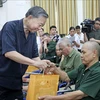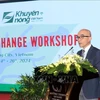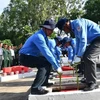Central Highland province of Dak Lak possesses huge renewable energy sources. Over the past time, the province has effectively exploited and used these potentials and contributed to regional and local energy security. Report by the Vietnam Business Forum.
Dak Lak is considered to have rich hydropower potential. According to the statistics of the Department of Industry and Trade, the province has put into use 12 small hydropower plants with a combined capacity of 73.14MW.
Hydropower plants supply the local grid and support the national grid when necessary. Power sources from these plants also help reduce the overload of some 110-KV transformer stations and ensure stable operation of the power system.
Like hydropower, Dak Lak also has great potential for solar power production. In 2002, in a joint project between NRW Company (Germany) and Ho Chi Minh City - Solarlab Physics Institute’s branch under the Ministry of Natural Resources and Environment, an experimental solar power application model was deployed in Cham village, Ea H'leo district.
This is the first mountainous village to use solar power in Vietnam, accessed by all the 180 households. In the coming time, a big solar power project will be invested and deployed in Dak Lak.
To tap wind power potential in the province, Hanoi-based Infrastructure Investment and Urban Business Joint Stock Company installed two wind measurement poles in Ea Khal commune, Ea H'leo district.
Besides, the Binh Thuan Wind Power Corporation, based in Binh Thuan province, erected wind measurement turbine towers in the campus of Thanh Vu cassava starch factory in Ea H'leo commune, Ea H'leo district. Abundant wind energy potentials in Dak Lak will open up great opportunities for building wind-to-power plants in the province in the future.
Regarding biogas sources, in the framework of biogas programme along with animal husbandry, Dak Lak has trained 21 technicians and 22 builders. Beside the 3,947 projects funded by the national biogas project, people in the province also self-invested to build 6,000 biogas works, bringing the total biogas projects to over 10,000. Furthermore, the Dak Lak starch processing plant has put to use its biogas system to supply energy for drying 100 percent of starch.
As an agriculture-based province, with farming area accounting for 91.8 percent of total land area, of which forestland is about 47 percent, perennial tree area is approximately 20 percent, and paddy area is about 5.5 percent. Abundant biomass energy from logs, rice husk, bagasse, wood chips, sawdust, and agricultural by-products is diversifying biomass sources with huge reserves but application and exploitation of energy sources remains modest.
Sugar Joint Stock Company 333 has upgraded its processing capacity to 2,500 tonnes of sugarcane a day. The factory also invested a new energy system with a steamer of 60 tonnes and a turbine complex of 3,000KW, bringing the total power generating capacity of the factory to 4.5MW.
The potentiality of renewable energy sources in the province of Dak Lak is still very large. According to the project of evaluating the reality and building economical and efficient energy using programmes in Dak Lak province in 2011-2015, with a vision to 2020, Dak Lak strives to increase the proportion of power sourced from new energy and renewable energy to 25 percent of total power consumption in the province by 2015, equivalent to 112MW (out of 444 MW planned for 2015 in the province.)
Vo Thanh, Director of the Department of Industry and Trade, said Dac Lak will focus on investing and utilising renewable energy sources efficiently, protecting the environment and ensuring energy security for socioeconomic development demand.-VNA
Dak Lak is considered to have rich hydropower potential. According to the statistics of the Department of Industry and Trade, the province has put into use 12 small hydropower plants with a combined capacity of 73.14MW.
Hydropower plants supply the local grid and support the national grid when necessary. Power sources from these plants also help reduce the overload of some 110-KV transformer stations and ensure stable operation of the power system.
Like hydropower, Dak Lak also has great potential for solar power production. In 2002, in a joint project between NRW Company (Germany) and Ho Chi Minh City - Solarlab Physics Institute’s branch under the Ministry of Natural Resources and Environment, an experimental solar power application model was deployed in Cham village, Ea H'leo district.
This is the first mountainous village to use solar power in Vietnam, accessed by all the 180 households. In the coming time, a big solar power project will be invested and deployed in Dak Lak.
To tap wind power potential in the province, Hanoi-based Infrastructure Investment and Urban Business Joint Stock Company installed two wind measurement poles in Ea Khal commune, Ea H'leo district.
Besides, the Binh Thuan Wind Power Corporation, based in Binh Thuan province, erected wind measurement turbine towers in the campus of Thanh Vu cassava starch factory in Ea H'leo commune, Ea H'leo district. Abundant wind energy potentials in Dak Lak will open up great opportunities for building wind-to-power plants in the province in the future.
Regarding biogas sources, in the framework of biogas programme along with animal husbandry, Dak Lak has trained 21 technicians and 22 builders. Beside the 3,947 projects funded by the national biogas project, people in the province also self-invested to build 6,000 biogas works, bringing the total biogas projects to over 10,000. Furthermore, the Dak Lak starch processing plant has put to use its biogas system to supply energy for drying 100 percent of starch.
As an agriculture-based province, with farming area accounting for 91.8 percent of total land area, of which forestland is about 47 percent, perennial tree area is approximately 20 percent, and paddy area is about 5.5 percent. Abundant biomass energy from logs, rice husk, bagasse, wood chips, sawdust, and agricultural by-products is diversifying biomass sources with huge reserves but application and exploitation of energy sources remains modest.
Sugar Joint Stock Company 333 has upgraded its processing capacity to 2,500 tonnes of sugarcane a day. The factory also invested a new energy system with a steamer of 60 tonnes and a turbine complex of 3,000KW, bringing the total power generating capacity of the factory to 4.5MW.
The potentiality of renewable energy sources in the province of Dak Lak is still very large. According to the project of evaluating the reality and building economical and efficient energy using programmes in Dak Lak province in 2011-2015, with a vision to 2020, Dak Lak strives to increase the proportion of power sourced from new energy and renewable energy to 25 percent of total power consumption in the province by 2015, equivalent to 112MW (out of 444 MW planned for 2015 in the province.)
Vo Thanh, Director of the Department of Industry and Trade, said Dac Lak will focus on investing and utilising renewable energy sources efficiently, protecting the environment and ensuring energy security for socioeconomic development demand.-VNA



















